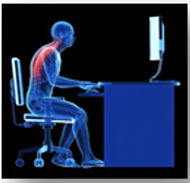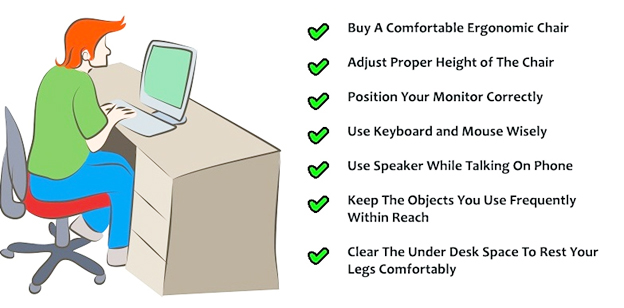The study of the design of a workplace, equipment, machine, tool, product, environment, and system which takes into consideration of human being’s physical, physiological, biomechanical, and psychological capabilities and optimizes the effectiveness and productivity of work systems while assuring the safety, health, and well being of the workers (Fernandez and Marley, 1998), which suggests as the goal of ergonomics is to fit the task to the individual, not the individual to the task. Practicing good ergonomics achieves increased productivity, improved health and safety of workers, higher job satisfaction and better compliance with the government regulations. The general ergonomics principles that should be applied to the workplace include aiming for dynamics versus static work, optimizing work surface heights, avoiding overload of muscles, avoiding unnatural postures, and training individuals to use the workplace, facility, and equipment properly. The key ergonomic issues are the anthropometry (the measurement of height, elbow-wrist length etc of human beings), seat design, manual material handling and trauma disorders.


Risk Factors
The occupational risk factors include awkward postures, excessive manual force, high rates of manual repetition, and long task duration or inadequate rest. In addition to these static loading (of muscle required to generate tension without movement), and vibration (Cause constriction of blood vessels may lead to numbness and swelling of muscle tissues) may also increase the risk of physical ailments.
Ergonomic Causeways and Ailments
Poor ergonomics facilitates the Cumulative Trauma Disorders (CTDs), the physical injuries, which develop over a period of times as a result of repeated biomechanical or physiological stresses on a particular body part. CTD is a collective term for syndromes characterized by discomfort, impairment, disability, or persistent pain in joints, muscles, tendons and other soft tissues (Kroemer, 1989). This includes repetitive trauma injuries (RTI), repetitive strain injuries (RSI), musculoskeletal disorders (MSD) and occupational overuse syndrome.
Some cases in point are Tendon Disorders (disorders in the specialized type of tissue connects muscles to bones), Tendinitis (inflammation of the tendon from repeated action), Tenosynovitis (loss of the lubricating ability of the synovial sheath resulting in inflammatory reaction), Bursitis (inflammatory response caused by the friction in the bursae), Ganglionic cyst (related to wrist usage which is caused by the swelling of a tendon sheath with synovial fluid), Neurovascular disorders (CTDs which involve both the nerve and the adjacent blood vessels), Thoracic Outlet Syndrome (compression of the nerves and blood vessels between the neck and shoulder, also known as cervicobrachial disorder), Vibration Syndrome (vibration-white finger-blanching, coldness and pain of the fingers due to closure of the digital arteries),and Carpal Tunnel Syndrome (compression of the median nerve associated with repeated or sustained activities of fingers and hands, often combined with the application of force, as well as pressure from hard work surfaces and sharp edges on hand tools).
Ergonomic Principles
The good practices which should be applied to the workplace, whether in an industrial or an office environment, include the following:
1. Aim at dynamic work, avoid static work, avoid unnatural postures and permit change of postures.
2. Adjust work surface heights to the size of the worker and the type of task performed.
3. Work within 30% of one’s maximum voluntary contraction (strength). Avoid overloading of the muscular system.
4. Place primary controls, devices and work pieces within the normal working area to reduce extended reaches and fatigue.

5. Work with both hands.
6. Use feet as well as the hands.
7. Design knowing the capacity of fingers. Do not overload the fingers.
8. Use gravity.
9. Provide sufficient room to move around.
10. Train the individual to use the workplace, facility and equipment properly.
Thus understanding ergonomics and applying proactive ergonomic measures to our lives both at work and at home is important.
A wrist held level won’t attract the doctor’s gavel!
Ananth Tamilmaniarasu
HSE Trainer,
Green World Group,
Dubai
For more Details contact:
